Intel SSD 520 Review: Cherryville Brings Reliability to SandForce
by Anand Lal Shimpi on February 6, 2012 11:00 AM ESTAnandTech Storage Bench 2011
Last year we introduced our AnandTech Storage Bench, a suite of benchmarks that took traces of real OS/application usage and played them back in a repeatable manner. I assembled the traces myself out of frustration with the majority of what we have today in terms of SSD benchmarks.
Although the AnandTech Storage Bench tests did a good job of characterizing SSD performance, they weren't stressful enough. All of the tests performed less than 10GB of reads/writes and typically involved only 4GB of writes specifically. That's not even enough exceed the spare area on most SSDs. Most canned SSD benchmarks don't even come close to writing a single gigabyte of data, but that doesn't mean that simply writing 4GB is acceptable.
Originally I kept the benchmarks short enough that they wouldn't be a burden to run (~30 minutes) but long enough that they were representative of what a power user might do with their system.
Not too long ago I tweeted that I had created what I referred to as the Mother of All SSD Benchmarks (MOASB). Rather than only writing 4GB of data to the drive, this benchmark writes 106.32GB. It's the load you'd put on a drive after nearly two weeks of constant usage. And it takes a *long* time to run.
1) The MOASB, officially called AnandTech Storage Bench 2011 - Heavy Workload, mainly focuses on the times when your I/O activity is the highest. There is a lot of downloading and application installing that happens during the course of this test. My thinking was that it's during application installs, file copies, downloading and multitasking with all of this that you can really notice performance differences between drives.
2) I tried to cover as many bases as possible with the software I incorporated into this test. There's a lot of photo editing in Photoshop, HTML editing in Dreamweaver, web browsing, game playing/level loading (Starcraft II & WoW are both a part of the test) as well as general use stuff (application installing, virus scanning). I included a large amount of email downloading, document creation and editing as well. To top it all off I even use Visual Studio 2008 to build Chromium during the test.
The test has 2,168,893 read operations and 1,783,447 write operations. The IO breakdown is as follows:
| AnandTech Storage Bench 2011 - Heavy Workload IO Breakdown | ||||
| IO Size | % of Total | |||
| 4KB | 28% | |||
| 16KB | 10% | |||
| 32KB | 10% | |||
| 64KB | 4% | |||
Only 42% of all operations are sequential, the rest range from pseudo to fully random (with most falling in the pseudo-random category). Average queue depth is 4.625 IOs, with 59% of operations taking place in an IO queue of 1.
Many of you have asked for a better way to really characterize performance. Simply looking at IOPS doesn't really say much. As a result I'm going to be presenting Storage Bench 2011 data in a slightly different way. We'll have performance represented as Average MB/s, with higher numbers being better. At the same time I'll be reporting how long the SSD was busy while running this test. These disk busy graphs will show you exactly how much time was shaved off by using a faster drive vs. a slower one during the course of this test. Finally, I will also break out performance into reads, writes and combined. The reason I do this is to help balance out the fact that this test is unusually write intensive, which can often hide the benefits of a drive with good read performance.
There's also a new light workload for 2011. This is a far more reasonable, typical every day use case benchmark. Lots of web browsing, photo editing (but with a greater focus on photo consumption), video playback as well as some application installs and gaming. This test isn't nearly as write intensive as the MOASB but it's still multiple times more write intensive than what we were running last year.
As always I don't believe that these two benchmarks alone are enough to characterize the performance of a drive, but hopefully along with the rest of our tests they will help provide a better idea.
The testbed for Storage Bench 2011 has changed as well. We're now using a Sandy Bridge platform with full 6Gbps support for these tests.
AnandTech Storage Bench 2011 - Heavy Workload
We'll start out by looking at average data rate throughout our new heavy workload test:
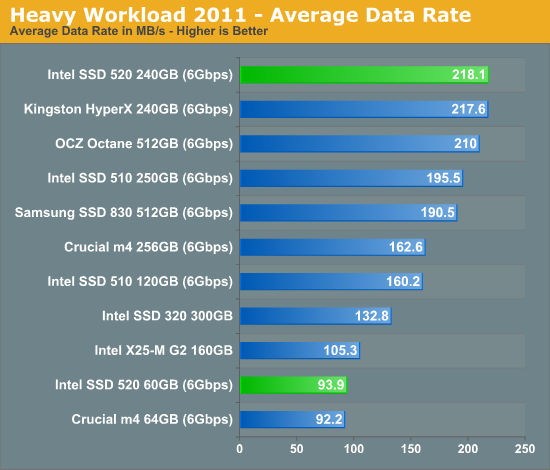
SandForce has always done well in our Heavy Workload test, and the 520 is no different. For heavy multitasking workloads, the 520 is the fastest SSD money can buy. Note that its only hindrance is incompressible write speed, which we do get a hint of in our breakdown of read/write performance below.

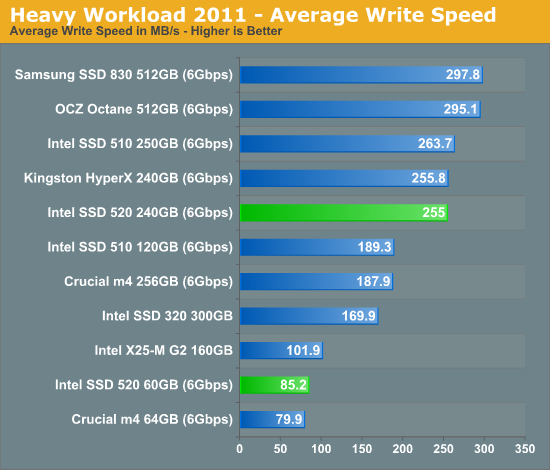
The next three charts just represent the same data, but in a different manner. Instead of looking at average data rate, we're looking at how long the disk was busy for during this entire test. Note that disk busy time excludes any and all idles, this is just how long the SSD was busy doing something:
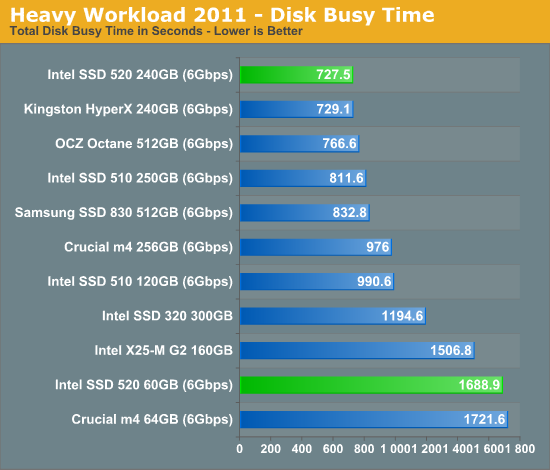
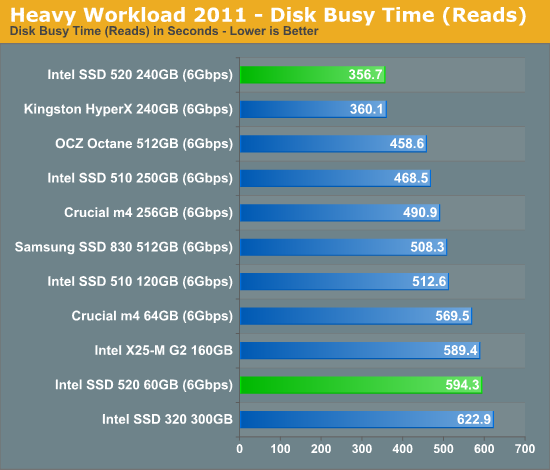
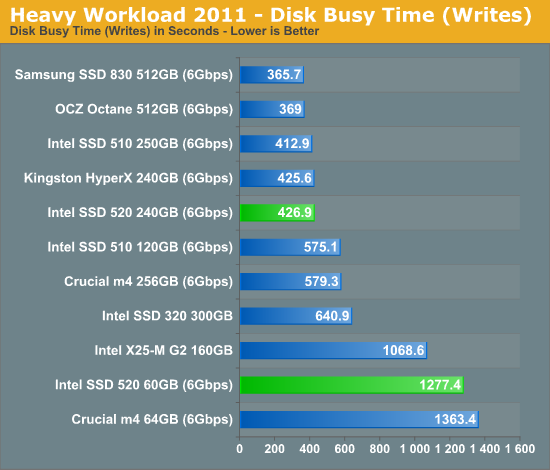










138 Comments
View All Comments
km23 - Monday, February 6, 2012 - link
What drive would you suggest for a Mac Pro? I have an early 2008 with 3G connection. I keep reading about the Mercury drives from Macsales. Any suggestions? Thanks.Beenthere - Monday, February 6, 2012 - link
WAIT for SSD makers to sort the Bugs out of their SSDs. Contrary to what Intel says, I think that's the only way we will have any idea of the reliability of the 520 series SSDs. Maybe in 12 months enough guinea pigs will have found most of the Bugs.troystarr - Tuesday, February 7, 2012 - link
I understand why IOPS would go down for smaller capacity drives with fewer NAND die to interleave, but I'm curious why it would go down when the capacity goes up.haa - Tuesday, February 7, 2012 - link
When using SSDs in laptops whole disk encryption is often required (and easy to enable with e.g. FileVault 2 on Macs) so it is not just a corner case as the computer is writing incompressible (encrypted) data all the time, bringing out the worst case performance case probably pretty soon...Cow86 - Tuesday, February 7, 2012 - link
So now that the belated 520 has finally shown up (originally Q4 according to the roadmap), will the other SSD that also should've been out already also show up soon? The successor to the intel 311, hawley creek? Kinda been waiting for that one for a reliable, and hopefully cheaper, caching SSD....Enough capacity means getting 180GB or more, which is too expensive from any vendor at this time for me, and I'm not too sure about using a 60 GB SSD for caching either, with regards to reliability....Hawley Creek seems to have completely dissapeared off the radar though :/fausto412 - Tuesday, February 7, 2012 - link
these things still have reliability issues?Westyfield2 - Tuesday, February 7, 2012 - link
Intel say:"Superior data protection features: The new Intel SSD 520 Series offers the best security features of any Intel SSD to date and comes preconfigured with Intel® Advanced Encryption Standard New Instructions (Intel® AES-NI) 256-bit encryption capabilities. In the event of theft or loss of your computer, you have the peace of mind that your personal data is secured by an advanced encryption technology. Additionally, the Intel SSD 520 Series contains “End-to-End Data Protection” ensuring integrity of stored data from the computer to the SSD and back."
Any details Anand? Here's a forum thread about FDE on the Intel 320. http://communities.intel.com/thread/20537?tstart=0
I, for one, would be very interested in an FDE SSD (I remember Samsung did one a few years ago, but that's all gone quiet).
panthal - Tuesday, February 7, 2012 - link
I find it odd Anand or anyone else doesn't think what Intel as has done is shady as hell.All the issues were not with the Sandforce controller.It was also partly how the Intel chip-sets handled power schemes and other advanced parts of the power management.Intel one was one of the MAIN vendors pushing for some of the more advanced power settings,then DISABLED them on their own Intel branded SSD drives.What does that tell you?The Sandforce fixes didn't come because Intel didn't want them sorted till it got closer to time for their own Intel branded Sandforce drives.They helped just enough to get the last firmware pushed that solved most the Sandforce issues.
Call it conspiracy if you want,but it's all there if you care to look.
Beenthere - Tuesday, February 7, 2012 - link
Perish the thought that Intel would ever operate in any manner than with the utmost integrity and respect for it's customers and the PC industry.http://www.theinquirer.net/inquirer/news/2120866/i...
NitroWare - Wednesday, February 8, 2012 - link
Some of the SATA power management schemes were convinced years ago before cheap SSDs became mainstream. Intel did not invent SATA by itself.No logic is perfect, even from Intel.
As for claiming Intel has somehow thrown a wrench into the gears thats a bit foolish. Corsair, OCZ and Kingston amongst others put their reputations on the line when these issues arise. These firms do not sell $300-$2000 CPUs that make up their revenue. For some tech firms, a product recall is the last thing they will ever want to do.
Apparently these cheap SATA III SandForce SSDs are selling like hotcakes in some regions from what some channel distributors tell me and they can't keep enough stock to meet demand or the vendors have to shift stock allocations between regions to meet such demands, annoying other regions.
Consumers want cheap SSDs, regardless of who they are from. No consumer will buy an ultra enterprise product for $2000. You can not have your cake and eat it too.
If there is a genuine issue with a product, either a fix will be made available or worst case swap under warranty for a revised product.
For specific motherboard support blame the mobo vendors. They are reluctant to patch BIOSes for older models such as adding the latest Intel Option ROM. Many angles to this. Manpower, validation, lazy, no care factor, pushing newer models, open a can of worms and so on. They can get the latest drivers, firmwares or fixes if they want, if they still buy particular chips they are provided with support. If they don't use this support its their fault.
Some are even reluctant to patch new boards.